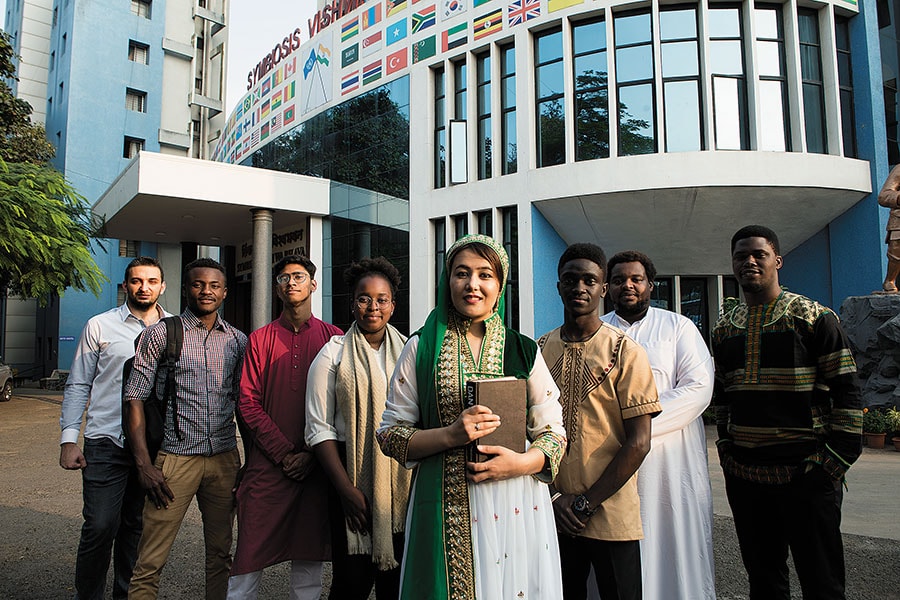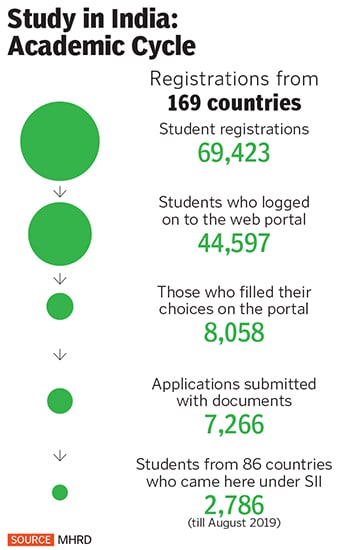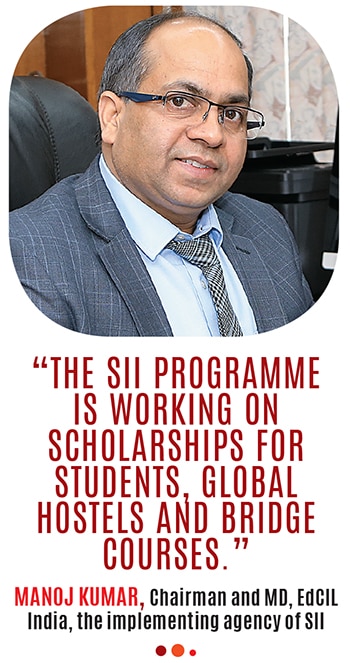
Study in India: Attracting foreign students in the age of campus turmoil?
The Study in India programme is taking baby steps to attract more students to the country, but protests at university campuses will not help its cause in the short term
 Pune's Symbiosis International University has got 85 students via the Study in India initiative
Pune's Symbiosis International University has got 85 students via the Study in India initiativeImage: Jignesh Mistry for Forbes India
With a civil war raging in Syria for eight years, education there has suffered. “Many Syrian students want to complete their education, but are unable to do so as the situation there is pretty bad. Getting admission to colleges in Syria has become difficult because the government offers limited seats,” says Jafar Isa, 28, who found a way to pursue his studies by coming to India in October 2018 through the Study in India (SII) programme.
“Before coming here, I got admission in Czech Republic, Europe. But my parents were not comfortable sending me there because Europe is expensive. Within two weeks, I got a scholarship from the Study in India programme,” says Isa, a student of MSc economics at Symbiosis International University in Pune. “I’m grateful for this scholarship because of which I can pursue my masters... it wouldn’t have been possible to get this opportunity in my country. A lot of Syrian students have come here from cities which were under terrorist control and India has saved them.”
Isa is one of thousand Syrians who got a fully paid scholarship last year under SII, a joint initiative of the ministry of human resource development (MHRD), ministry of external affairs and ministry of commerce and industry, launched in April 2018 to streamline and attract international students to the country (the scheme shot into prominence when Finance Minister Nirmala Sitharaman announced it in her Budget 2019 speech).
According to the SII portal, there are 2,000 scholarships of $3,500 per annum available for “meritorious undergraduate and postgraduate students”.
“The focus of SII is not only to increase demand with students across the globe, but also to strengthen the supply side by providing support and facilitation services with allied institutions to international students,” says Manoj Kumar, chairman and managing director, EdCIL India, a public sector undertaking and the implementing agency of the SII programme. “The SII programme is working on scholarships for students, global hostels and bridge courses. We are also updating our website and building a multi-lingual interface. Our team will soon be expanding to regions like Asean, Middle East and other developed economies where India needs to further build and develop its global identification as an education hub.”

India is ranked third in terms of higher educational network with more than 38,000 colleges and over 800 universities. However, it ranks 26th among the top destinations for international student mobility, globally. The top 10 countries constitute 63.7 percent of the total foreign students enrolled and according to the 2018-19 data by All India Survey on Higher Education, there were over 47,000 international students (accounting for 1 percent of global international student mobility) studying in higher educational institutes in India. The aim is to attract 1.5-2.5 lakh international students by 2022 and jump to No 15 in the world in attracting international students, according to the EdCIL-CII Survey on Internationalisation of Indian Campuses 2019.
“The initiative also caters to the demand from developed markets through collaborations with selected institutions that offer niche courses in yoga, Buddhism, Tibetan studies, ayurveda and more. The target markets are Europe, Latin America, North America and Middle East,” says Kumar.
Ten years ago, Fawzia Merzaye, 26, from Afghanistan had got a scholarship to India from the Balkh province, but her family did not allow her to travel for higher studies. “Due to regional fanaticism and conditions at the time, my family opposed the move. But luckily, over the years, there have been significant changes... now girls have the right to study and can go out of the country to pursue further education. When I got an offer from the Symbiosis International University, I was extremely happy,” says Merzaye, who came to India in August 2018 via the SII programme and is pursuing an MBA in agri business.
More than 150 institutions in India have enrolled with EdCIL to offer seats and scholarships for international students, including top universities from IITs and IIMs, NITs, the OP Jindal Global University, Narsee Monjee Institute of Management Studies (NMIMS) and the Symbiosis International University.
“Since the inception of SII, we have partnered with the National Institutional Ranking Framework (NIRF) and National Assessment and Accreditation Council (NAAC) certified institutions in the country. We cater to NIRF Top 100 institutes in any category except medical institutes, along with a NAAC accreditation of 3.26 or above and those which have been empanelled by UGC, be it government or private,” says Kumar.
The government provisioned ₹50 crore in the 2018-2019 Budget and ₹65 crore in the 2019-2020 Budget for the programme, primarily for brand promotion activities. Besides attracting students, the idea is to build quality institutions. In Budget 2019, the government increased the allocation for “world-class institutions” to ₹400 crore from ₹128.9 crore, to “establish ten world-class institutions each in public and private sector in a reasonable time”.

According to MHRD, till August 2019, 7,266 students had submitted their final applications on the SII portal. After evaluation, it brought 2,786 students from 86 countries to India, a majority of them from Nepal, Ethiopia, Bangladesh, Afghanistan, Bhutan, Sri Lanka, Uganda, Tanzania, Nigeria and Indonesia.
The Symbiosis International University, which has had global students since 1971, supported EdCIL in creating a lot of the processes. “We’ve streamlined our admission process for foreign students. This is why we were involved in SII. We are happy the government has initiated this programme because this is what was done by the founder of Symbiosis, Dr Mazumdar, way back in 1971,” says Dr Vidya Yeravdekar, pro chancellor of Symbiosis International University, which has got 85 students so far through the SII initiative.
Colleges like NMIMS and IIT-Madras have not seen foreign students coming specifically through SII as of now. “The institute started advertising it four months ago. It hopes that it will start to see fruits of that outreach in the coming semester,” says Prof Mahesh Panchagnula, dean (international and alumni relations) at IIT-Madras.
There are other challenges that need to be addressed. “The average GMAT score to get admission in a two-year MBA PGPX programme at IIM-Ahmedabad is more than 700. So students who are academically strong and get the desired score have an opportunity to study in any country. There are less chances of them opting to study in India because they have better options for colleges. Also, they will get better job opportunities in other countries,” says a faculty member from IIM-Ahmedabad.
According to Dr Yeravdekar, a lot of universities don't want foreign students because they don't want to get into too many hassles. “This is because the students come from a weak education background and need to be trained well. Nobody wants to put in those efforts. Our teachers have to train these international students before they start pursuing their course. How many of us are willing to do that? Universities need to understand that in the long run, it’s going to pay not only for us but for our country as well.” She adds that the Indian embassies across the world needs to be proactive and the higher education system here needs to be marketed well. “It's not just about attracting students, we need to ease out things like visa issues, their internship as well as employability,” says Dr Yeravdekar.
Besides, with students from esteemed universities agitating against fee hikes, the stifling of democracy and incidents of police action against students, the SII programme has a major challenge in projecting India as a global educational hub.
(This story appears in the 31 January, 2020 issue of Forbes India. To visit our Archives, click here.)


















